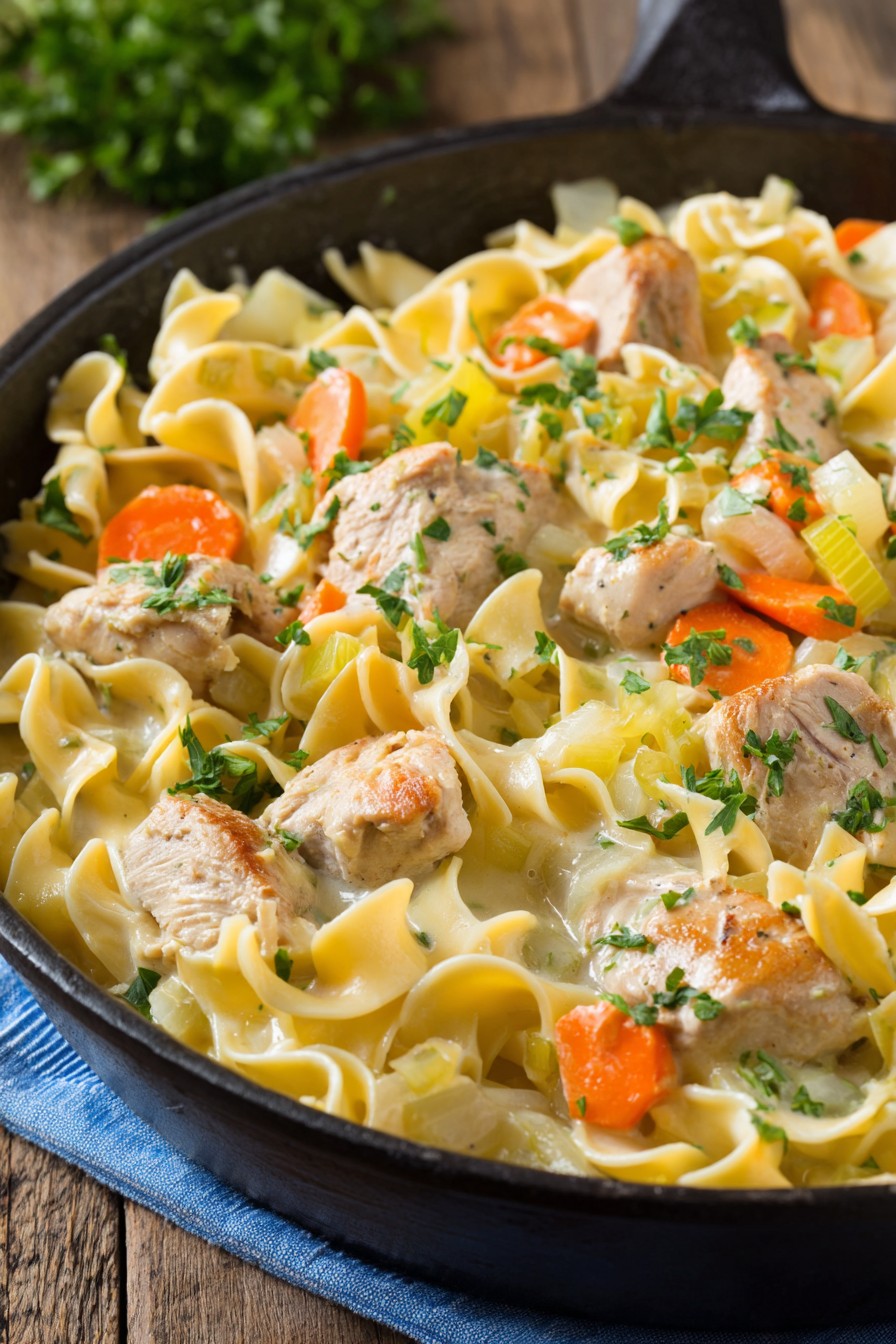Oh my goodness, folks – if you’re looking for that perfect bowl of cozy comfort that hugs your soul from the inside out, you’ve stumbled upon the right recipe! Our chicken and noodles is the kind of dish that makes you want to curl up on the couch with a blanket, whether it’s a chilly evening or you just need a little culinary TLC. This isn’t just any old recipe; it’s my go-to for family dinners, potlucks, and those days when only carbs and tender chicken will do.
Why This Recipe Works
- Using a combination of chicken thighs and breasts ensures both rich flavor and tender, juicy meat that doesn’t dry out during cooking.
- Simmering the noodles directly in the broth allows them to absorb all the savory goodness, creating a deeply flavorful and cohesive dish without any bland or watery bits.
- A quick roux made with butter and flour thickens the sauce perfectly, giving it a velvety texture that clings to every noodle and piece of chicken.
- Fresh herbs like thyme and parsley added at the end provide a bright, aromatic lift that cuts through the richness and makes each bite pop with freshness.
- Cooking the vegetables until just tender-crisp retains their texture and nutrients, adding a delightful crunch and color contrast to the soft noodles and chicken.
Ingredients
- 1.5 pounds boneless, skinless chicken thighs, cut into 1-inch cubes
- 1 pound boneless, skinless chicken breasts, cut into 1-inch cubes
- 2 tablespoons olive oil
- 1 large yellow onion, finely diced
- 3 medium carrots, peeled and sliced into 1/4-inch rounds
- 3 celery stalks, finely chopped
- 4 cloves garlic, minced
- 6 cups low-sodium chicken broth
- 2 cups water
- 12 ounces wide egg noodles
- 1/2 cup unsalted butter
- 1/2 cup all-purpose flour
- 1 cup heavy cream
- 2 teaspoons dried thyme
- 1/4 cup fresh parsley, chopped
- Salt and black pepper to taste
Equipment Needed
- Large Dutch oven or heavy-bottomed pot
- Wooden spoon or spatula
- Chef’s knife
- Cutting board
- Measuring cups and spoons
- Whisk
Instructions

Step 1: Sear the Chicken to Perfection
Heat the olive oil in your large Dutch oven over medium-high heat until it shimmers – you should see little waves forming on the surface, which indicates it’s ready for action. Pat the chicken cubes dry with paper towels (this is crucial for getting that beautiful golden-brown sear instead of steaming them) and season generously with salt and pepper. Working in batches to avoid overcrowding the pot, add the chicken in a single layer and let it cook undisturbed for 3-4 minutes per side until deeply browned and crispy on the edges. Don’t be tempted to stir too early – that initial sear creates fond (those delicious browned bits at the bottom) that will add incredible flavor to your broth. Remove the chicken with a slotted spoon and set aside, leaving all those tasty drippings in the pot for the next step.
Step 2: Sauté the Aromatics and Vegetables
Reduce the heat to medium and add the diced onion, carrot rounds, and chopped celery to the same pot – no need to clean it first because we want all that chicken goodness! Cook for 6-8 minutes, stirring occasionally, until the vegetables begin to soften and the onions turn translucent with slightly golden edges. Add the minced garlic and cook for another minute until fragrant – you’ll know it’s ready when your kitchen smells absolutely heavenly. This step builds layers of flavor as the vegetables release their natural sugars and mingle with the chicken drippings. The carrots should still have a slight crunch at this stage since they’ll continue cooking later. Tip: If the bottom of the pot looks like it’s browning too much, add a splash of chicken broth to deglaze and scrape up all those flavorful bits.
Step 3: Create the Roux and Build the Broth
Push the vegetables to the sides of the pot and add the butter to the center, letting it melt completely and bubble gently. Sprinkle in the flour and immediately start whisking constantly to combine – you’re making a roux, which will thicken our sauce beautifully. Cook the roux for 2-3 minutes until it turns a light golden color and smells nutty, whisking the entire time to prevent burning. Gradually pour in the chicken broth and water while whisking continuously to avoid lumps – this slow incorporation is key to a smooth, velvety base. Bring the mixture to a gentle boil, then reduce heat to maintain a steady simmer. Add the dried thyme and return the seared chicken to the pot along with any accumulated juices.
Step 4: Cook the Noodles to Al Dente Perfection
Step 5: Finish with Cream and Fresh Herbs
Reduce the heat to low and stir in the heavy cream – this adds richness and helps create that luxurious, velvety sauce that makes this dish so irresistible. Let it heat through for 2-3 minutes without boiling (boiling can cause the cream to curdle), just until everything is warmed through and beautifully combined. Remove from heat and stir in the fresh parsley – the residual heat will wilt it perfectly while preserving its bright, fresh flavor. Taste and adjust seasoning with additional salt and pepper if needed. Let the dish rest for 5 minutes before serving – this allows the flavors to meld together and the sauce to thicken to the perfect consistency. Tip: The noodles will continue to absorb liquid as it sits, so if you’re not serving immediately, you might need to add a splash of warm broth when reheating.
Tips and Tricks
For the absolute best flavor, consider using homemade chicken broth if you have it – it makes a noticeable difference in depth and richness compared to store-bought. If using store-bought broth, opt for low-sodium versions so you can control the salt level yourself. When searing the chicken, make sure your pot is properly preheated and don’t overcrowd it – this ensures that beautiful brown crust instead of steaming the meat. If you’re short on time, you can use rotisserie chicken; just add shredded cooked chicken during the last 5 minutes of cooking to warm through without making it tough. For extra flavor dimension, add a Parmesan rind to the broth while simmering – it melts into the sauce and adds incredible umami depth. If your sauce seems too thick after adding the noodles, simply stir in additional warm broth or water until it reaches your desired consistency. Conversely, if it’s too thin, mix 1 tablespoon of cornstarch with 2 tablespoons of cold water and stir it in during the last minute of cooking. For make-ahead convenience, you can prepare the entire dish except the noodles; cook the noodles separately and combine when ready to serve to prevent them from becoming mushy. Leftovers will thicken significantly in the refrigerator; reheat gently on the stove with additional broth or cream to restore the creamy texture. Freeze portions without the cream and noodles for best results; add those fresh when reheating. For a lighter version, substitute half-and-half for the heavy cream, though the sauce will be slightly less rich. Always taste and adjust seasoning at the end – the saltiness can vary based on your broth and personal preference.
Recipe Variations
- Creamy Mushroom Chicken and Noodles: Sauté 8 ounces of sliced cremini mushrooms with the vegetables for an earthy, umami-packed twist. Add a splash of white wine when deglazing the pan for extra depth.
- Spicy Southwest Style: Add 1 tablespoon chili powder, 2 teaspoons cumin, and 1 diced jalapeño with the vegetables. Stir in 1 cup of corn and 1 can of drained black beans with the chicken, and top with cilantro instead of parsley.
- Italian Herb Chicken and Noodles: Replace the thyme with 1 tablespoon Italian seasoning and add 1/2 cup grated Parmesan with the cream. Stir in 2 cups of fresh spinach during the last 2 minutes of cooking.
- Thai Coconut Curry Version: Substitute coconut milk for the heavy cream and add 2 tablespoons red curry paste with the garlic. Finish with lime juice and fresh basil instead of parsley for an Asian-inspired twist.
- Hearty Vegetable-Packed: Double the carrots and celery, and add 1 cup each of frozen peas and diced potatoes with the broth for a chunkier, more vegetable-forward dish that’s still incredibly comforting.
Frequently Asked Questions
Can I use different types of noodles in this recipe?
Absolutely! While wide egg noodles are traditional and provide the perfect texture for holding the creamy sauce, you can substitute with other pasta shapes. Fettuccine or tagliatelle work beautifully as they’re similar in width and texture. For a healthier option, whole wheat egg noodles or even zucchini noodles can be used – though with zoodles, add them raw during the last 2 minutes of cooking to just wilt them. If using dried pasta instead of egg noodles, you may need to adjust the cooking time according to package directions and possibly add extra broth since different pastas absorb liquid differently. Just avoid very small shapes like orzo that might disappear into the sauce.
How should I store and reheat leftovers?
Store leftovers in an airtight container in the refrigerator for up to 3 days. The noodles will continue to absorb liquid, so when reheating, do it gently on the stove over low heat with additional broth or cream to restore the saucy consistency – microwave reheating can make the noodles rubbery. Stir frequently and add liquid gradually until it reaches your preferred thickness. If frozen, thaw overnight in the refrigerator before reheating. For best results, freeze without the cream and noodles; cook fresh noodles and add cream when reheating. The sauce may separate slightly when frozen and reheated due to the dairy, but vigorous whisking during reheating will help emulsify it again.
Can I make this recipe in a slow cooker or Instant Pot?
Yes to both! For slow cooker: Sear chicken and sauté vegetables as directed, then transfer everything except noodles and cream to the slow cooker. Cook on low for 6-7 hours or high for 3-4 hours. Add noodles and cook on high for another 20-30 minutes until tender, then stir in cream. For Instant Pot: Use sauté function to sear chicken and cook vegetables. Add broth and seasonings, pressure cook on high for 5 minutes with quick release. Switch to sauté, add noodles and cook until tender, then stir in cream. Both methods require adjusting liquid amounts – pressure cooking needs less liquid while slow cooking may need more. The noodles may become softer in these methods, so add them toward the end.
Summary
This chicken and noodles recipe delivers ultimate comfort with tender chicken, perfectly cooked noodles, and a velvety herb-infused sauce that comes together in one pot for easy cleanup and incredible flavor.
Chicken and Noodles
6
servings20
minutes40
minutesIngredients
Instructions
- 1 Heat oil in Dutch oven over medium-high heat. Season chicken with salt and pepper, sear in batches until browned. Remove and set aside.
- 2 Add onion, carrots, and celery to same pot. Cook until softened, about 6-8 minutes. Add garlic and cook 1 minute more.
- 3 Push vegetables aside, melt butter in center. Whisk in flour and cook 2-3 minutes. Gradually whisk in broth and water until smooth.
- 4 Bring to simmer, add thyme and return chicken. Stir in noodles and cook 8-10 minutes until al dente.
- 5 Reduce heat to low, stir in cream and heat through. Remove from heat, stir in parsley. Season to taste and serve.



